Anyone who pans for gold hopes to be rewarded by the glitter of colors in the fine material collected in the bottom of the pan. Although the exercise and outdoor activity experienced in prospecting are rewarding, there are few thrills comparable to finding gold. Even an assay report showing an appreciable content of gold in a sample obtained from a lode deposit is exciting.
Regardless of whether you are a new prospector or a pro, the gold pan is still the most indispensable companion you can have. It is one of the first tools used in locating gold and is one of the last used, even in commercial mining to check the value of ore being processed.
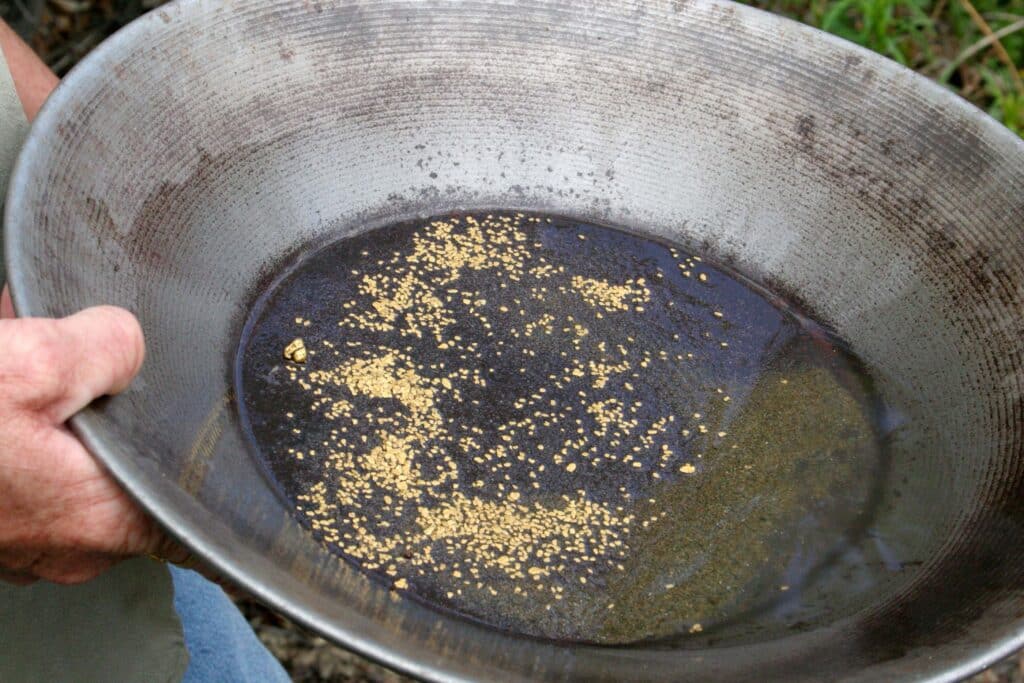
How to Pan for Gold
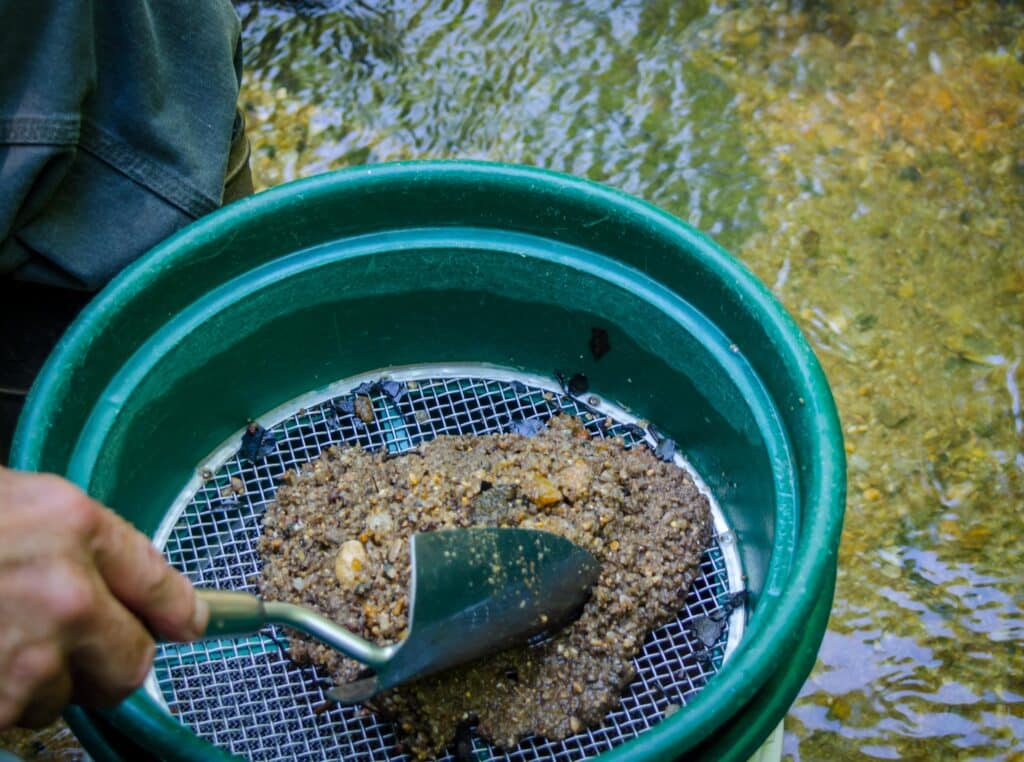
Fill the gold pan about half full of gravel, then submerge it deep enough in water (stream or tub) so it is just under the surface of the water. Next, give the pan several vigorous shakes back and forth and from side to side, but not too hard as to wash material out of the pan, you want to shake the gravel so the heavy gold sinks to the bottom of the pan and the less dense rocks and minerals float to the top of the pile in your pan.
Regardless of whether you are a new prospector or a pro, the gold pan is still the most indispensable companion you can have. It is one of the first tools used in locating gold and is one of the last used, even in commercial mining to check the value of ore being processed.
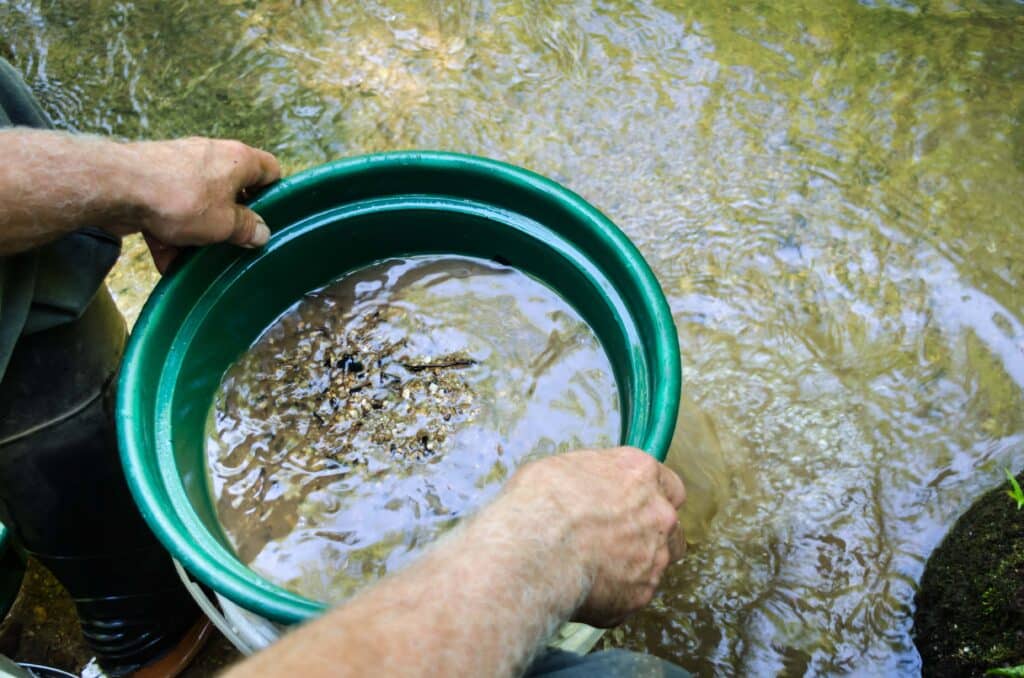
Change from the shaking motion to a gentle circular movement, so the remaining material starts turning in a circle. This process will cause most of the dirt and clay to dissolve and wash out of the pan. If roots and moss surface, work them over your pan with your fingers to dissolve any lumps. Pick out the larger rocks, pebbles, and debris after making sure that they are washed clean of any mud or sand. You want to try and recover as much gold as possible but you will lose some in the process so don’t be too gentle in the operation. Do this until you have the larger rocks and pebbles washed out of the pan.
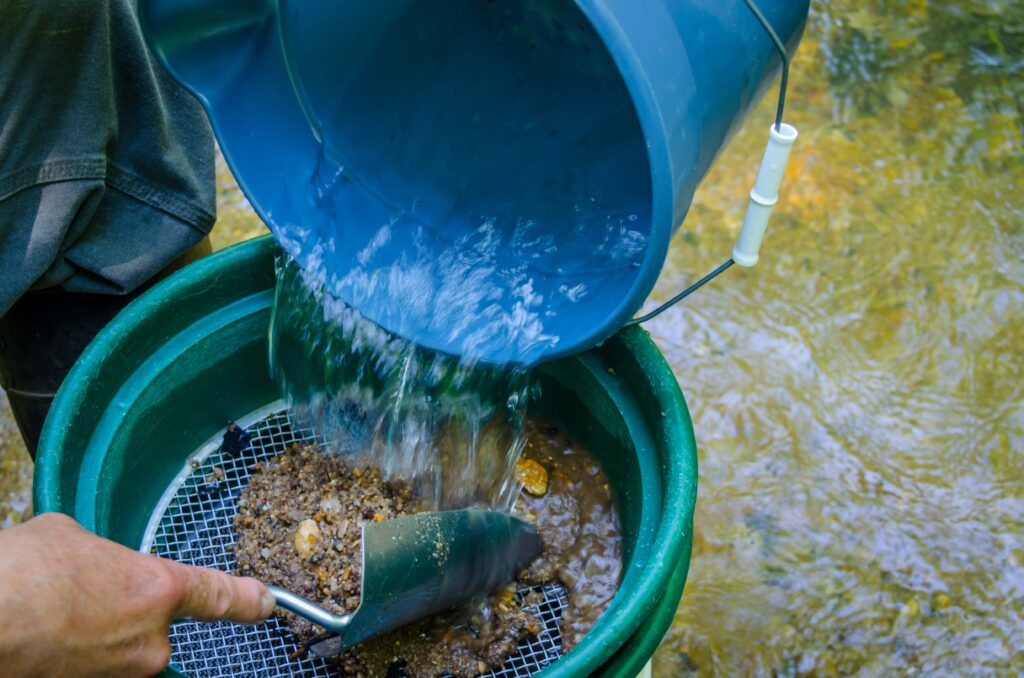
Now wash away the lighter sand and gravel. Hold the pan just under the water and tilt it slightly away from you. Begin to swirl the water from side to side, with a slight forward tossing motion. Take care, but with sufficient force to move the surface and the lighter gravel out over the edge of the pan. Leveling the pan out from time to time and shaking it back and forth will cause the light material to come to the surface and the gold to settle to the bottom. Keep working the pan until you are down to black sand and color(gold).
Now you will want to start carefully working the black sand. Now is the time to slow down and be careful. Leaving just a little water in the gold pan, lift the pan out of the water and use your tweezers to pick out any nuggets and large flakes and place these in your poke. You can use a magnet to separate the magnetite (black sand) from the gold. Continue panning the con down until it is about a third gold. As you pan, you will notice that the gold will form in a tail behind the black sand. At this time you can clean up the gold with your tweezers and eye dropper. Keep panning until you are out of gold or out of black sand in the bottom of the pan.
Learning How to Pan for Gold
The easiest way to learn how to pan for gold is to watch someone else do it first. You can’t appreciate how vigorously you have to shake the pan at the beginning until you see a master gold panner in operation. Many of the commercial gold panning tours in Alaska will teach you how to pan for gold and will get you into the color in about an hour. If you want to learn prior to coming up to Alaska, you should consider joining a local gold prospecting club. You will get the chance to practice and also see what other people are using. If you don’t have the time or desire to join a club the next best thing is to buy a video or book. I normally buy this type of specialized material from Amazon gold panning.
Panning for gold is a method for separating gold from other materials, such as soil or gravel, by using a pan. Here are the detailed steps to panning for gold:
- Choose a location: Look for areas near old gold mines or streams with a history of gold deposits.
- Prepare your equipment: You will need a gold pan, a shovel, a bucket, a classifier (a mesh screen to sift out larger rocks and debris), and a snuffer bottle (a small bottle with a suction nozzle to collect gold flakes).
- Gather materials: Use your shovel to gather soil, gravel, and rocks from the riverbank. Place the material into your bucket.
- Sift out larger rocks: Use your classifier to sift out the larger rocks and debris and keep the smaller material in your bucket.
- Fill your pan: Fill your gold pan about two-thirds full with the smaller material from your bucket.
- Wash out the dirt: Place the pan in the river or stream and gently swirl the material in a circular motion, using your wrist to generate the swirling motion. The water will wash out the dirt and leave the heavier minerals and gold in the pan. Repeat this process several times, gradually decreasing the amount of dirt and debris until only a small amount of material remains in the pan.
- Check for gold: Use your snuffer bottle to collect any gold flakes or nuggets in the material left in your pan.
- Repeat the process: Repeat the process of gathering materials, sifting, filling your pan, washing out the dirt, and checking for gold.
It’s important to note that gold panning takes patience and practice. It may take several trips to the river before you find any gold, but the excitement of finding it makes it all worth it. Additionally, always follow the rules and regulations for gold panning, and obtain any necessary permits before panning.
Now you will want to start carefully working the black sand. Now is the time to slow down and be careful. Leaving just a little water in the gold pan, lift the pan out of the water and use your tweezers to pick out any nuggets and large flakes and place these in your poke. You can use a magnet to separate the magnetite (black sand) from the gold. Continue panning the con down until it is about a third gold. As you pan, you will notice that the gold will form in a tail behind the black sand. At this time you can clean up the gold with your tweezers and eye dropper. Keep panning until you are out of gold or out of black sand in the bottom of the pan.
Gold panning kits are sets of equipment that are specifically designed for gold panning. They typically include all the tools and supplies needed to start panning for gold. Here’s what is typically included in a gold panning kit:
- Gold pan: The most essential tool for gold panning, a gold pan is a shallow, circular dish used to separate gold from other materials.
- Classifier: A classifier is a mesh screen used to sift out larger rocks and debris from the soil and gravel.
- Shovel: A shovel is used to gather soil, gravel, and rocks from the riverbank.
- Bucket: A bucket is used to carry the soil and gravel to the river or stream.
- Snuffer bottle: A snuffer bottle is a small bottle with a suction nozzle used to collect gold flakes or nuggets from the pan.
- Instructions: Most gold panning kits come with instructions on how to use the equipment and pan for gold.
Different types of gold panning kits may include additional tools and supplies, such as vials for storing gold, a magnifying glass, tweezers, and a black sand magnet. Some kits are designed for beginners and include only the basic tools, while others are designed for more experienced gold panners and include more advanced equipment.
When choosing a gold panning kit, it’s important to consider your experience level and the type of gold panning you plan to do. Some kits may be more suited for recreational gold panning, while others may be designed for more serious gold prospecting.
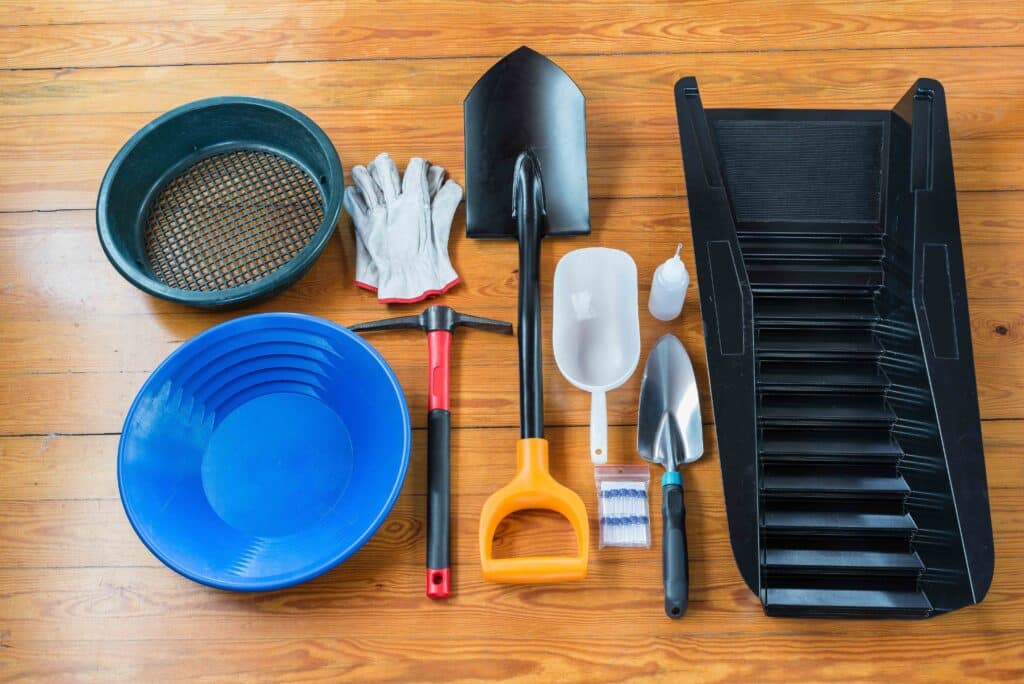
Gold Pans
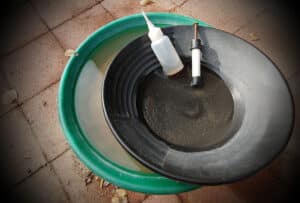
A gold pan is a shallow, circular dish used for separating gold from other minerals, soil, or gravel. It is the most essential tool for gold panning, a popular recreational activity where individuals search for gold in streams, rivers, or other bodies of water.
Gold pans are typically made of plastic or metal and are around 10 to 14 inches in diameter. They have low sides and a flat bottom, which allows for the easy swirling of soil and gravel in water to separate the heavier gold particles. The gold particles will settle to the bottom of the pan while the lighter material is washed away.
Gold pans come in different shapes and sizes, with some designed for specific types of gold panning. For example, some gold pans have ridges or riffles on the bottom to help retain the gold while washing away lighter materials.
Overall, the gold pan is a simple but effective tool for gold panning and a great way to get started in the hobby.
Overall, the classifier is a useful tool for gold panning and can be an essential part of a gold panning kit.
When it comes to gold panning, the right shovel can make a big difference in terms of efficiency and ease of use. Here are some of the best shovels for gold panning:
There are several different types of gold pans available on the market, each designed for a specific type of gold panning. Here are some of the most common types of gold pans:
- Traditional gold pan: A traditional gold pan is a simple, shallow circular dish with low sides and a flat bottom. It is made of plastic or metal and is typically 10 to 14 inches in diameter.
- Sluice box pan: A sluice box pan is a type of gold pan that has ridges or riffles on the bottom to help retain the gold while washing away lighter materials. It is designed to be used with a sluice box, a device that uses running water to separate gold from other materials, and is typically used for more serious gold prospecting.
- Vortex drop riffle pan: A vortex drop riffle pan is a type of gold pan that has a unique design that creates a vortex to help retain the gold while washing away lighter materials. It is designed to be more efficient than traditional gold pans and is often used by more experienced gold panners.
- Square gold pan: A square gold pan is a type of gold pan that is square or rectangular in shape and has low sides and a flat bottom. It is designed for gold panning in large rivers or streams and is often used by more experienced gold panners.
- Garrett gravity trap pan: A Garrett gravity trap pan is a type of gold pan that has a unique design that separates gold from other materials using gravity. It is designed to be more efficient than traditional gold pans and is often used by more experienced gold panners.
Gold Panning Classifier
A classifier is a mesh screen used in gold panning to separate larger rocks and debris from the soil and gravel. The classifier is typically used before panning to remove any larger material that would take up too much space in the gold pan and would not allow for the effective separation of the gold from the other materials.
The classifier is placed over a bucket or other container, and the soil and gravel are poured through it. The larger rocks and debris will fall into the container, while the smaller material will pass through the mesh and be kept for panning.
Using a classifier can save time and effort during the gold panning process, as it eliminates the need to manually remove larger rocks and debris from the soil and gravel. Using a classifier also helps to ensure that only the smaller, more gold-rich material is used for panning, maximizing the chances of finding gold.
Each type of gold pan has its own unique features and benefits, and the best type of pan for you will depend on your experience level and the type of gold panning you plan to do.
Types of Gold Panning Shovels
When choosing a shovel for gold panning, it’s important to consider the type of gold panning you plan to
It isn’t a bad way to go but not nearly as exciting as learning on a stream in the great outdoors.
- Foldable Shovel: A foldable shovel is compact and easy to carry, making it a great choice for gold panning. Many foldable shovels have a serrated edge, which can be useful for digging in soil and gravel.
- Military-style Shovel: A military-style shovel is a durable and versatile option for gold panning. It is often made of high-quality steel and can be used for digging, chopping, and scraping.
- Garden Shovel: A garden shovel is a lightweight and easy-to-use option for gold panning. It is often made of plastic or metal and has a flat blade that is ideal for scooping soil and gravel.
- Trowel: A trowel is a small and lightweight shovel that is ideal for gold panning in smaller streams and rivers. It is often made of plastic or metal and is easy to maneuver in tight spaces.
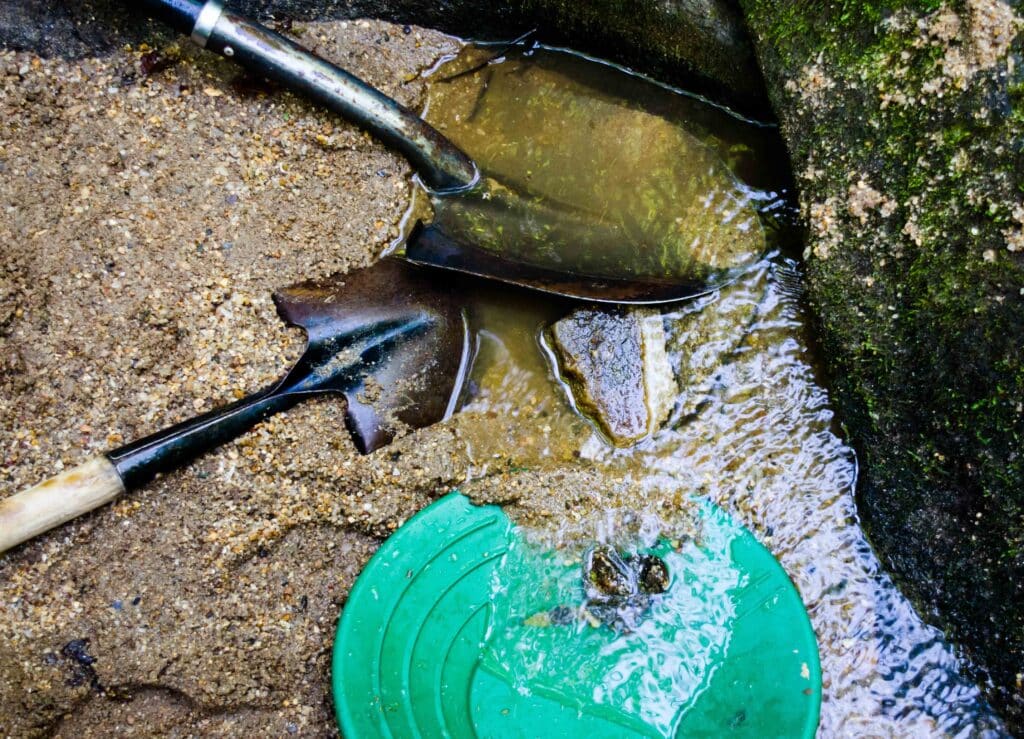
Gold Panning Buckets
Gold panning buckets are used to carry soil, gravel, and rocks from the riverbank to the gold panning location. There are several different types of gold panning buckets available, each with its own unique features and benefits. Here are some of the most common types of gold panning buckets:
- Collapsible Buckets: Collapsible buckets are designed to be easily folded down for convenient storage and transport. They are often made of lightweight, durable material and come in a variety of sizes.
- Plastic Buckets: Plastic buckets are a popular choice for gold panning due to their lightweight and durability. They are also often less expensive than other types of gold panning buckets.
- Metal Buckets: Metal buckets are a more durable option for gold panning, and are often favored by more experienced gold panners. They are typically made of steel or aluminum and come in a variety of sizes.
- Mesh Buckets: Mesh buckets are designed with a mesh bottom to make it easier to sift out larger rocks and debris before panning. They are often made of lightweight, durable material and come in a variety of sizes.
When choosing a gold panning bucket, it’s important to consider the type of gold panning you plan to do, as well as your personal preferences and needs. A durable and lightweight bucket is typically the best choice for gold panning, as it will make the process easier and more efficient. Additionally, consider the size of the bucket, as you will want a size that is large enough to carry enough material for gold panning, but small enough to be easily transported.
Gold Panning Snuffer Bottles
A snuffer bottle is a small bottle with a suction nozzle used in gold panning to collect gold flakes or nuggets from the gold pan. The nozzle is placed directly over the gold in the pan, and the bottle is squeezed to create suction, which pulls the gold into the bottle.
Snuffer bottles are an essential tool for gold panning, as they allow for the safe and easy collection of gold without the risk of losing any gold particles.
There are several different types of snuffer bottles available, and the best type for you will depend on your personal preferences and needs. Here are some of the most common types of snuffer bottles:
- Glass Snuffer Bottles: Glass snuffer bottles are made of glass and are often used by gold panners who prefer a more traditional or classic look.
- Plastic Snuffer Bottles: Plastic snuffer bottles are a popular choice due to their durability and lightweight. They come in a variety of colors and sizes.
- Metal Snuffer Bottles: Metal snuffer bottles are made of metal, such as stainless steel, and are a more durable option. They are often favored by more experienced gold panners.
- Squeeze Snuffer Bottles: Squeeze snuffer bottles are designed with a squeeze mechanism that creates suction, making it easier to collect gold from the pan.
When choosing a snuffer bottle, it’s important to consider the size of the nozzle, as a larger nozzle may be more effective for collecting larger gold particles, while a smaller nozzle may be better for collecting smaller gold particles. Additionally, consider the material of the bottle, as some materials are more durable and better suited for outdoor use than others.
Gold Panning in Alaska
Alaska is known for its rich gold history and is a popular destination for gold panning and gold prospecting. Here are some of the best places to pan for gold in Alaska:
- Fairbanks: Fairbanks is a popular destination for gold panning, and is known for its rich deposits of gold in the Chena River and other nearby creeks and streams.
- Nome: Nome is a popular destination for gold panning, and is known for its rich deposits of gold in the Nome River and other nearby creeks and streams.
- Juneau: Juneau is a popular destination for gold panning, and is known for its rich deposits of gold in Gold Creek, Silver Bow Basin, and the Taku River.
- Anchorage: Anchorage is a popular destination for gold panning, and is known for its rich deposits of gold in the Knik River and other nearby streams.
- Chicken: Chicken is a small town located in the heart of the historic Chicken Creek mining district. The town is known for its rich deposits of gold and is a popular destination for recreational gold panning.
Gold Panning in Fairbanks, Alaska
Fairbanks, Alaska is known for its rich gold history and is a popular destination for gold panning. Here are some of the best places to pan for gold in Fairbanks:
- Chena River: The Chena River is a popular spot for gold panning, and is located just outside of Fairbanks. The river is accessible via several parks and recreation areas and is known for its rich deposits of gold.
- Cleary Summit: Cleary Summit is a recreational mining area located about 40 miles north of Fairbanks. The area is known for its gold-rich streams and is a popular spot for gold panning.
- Chatanika River: The Chatanika River is located about 30 miles north of Fairbanks and is another popular spot for gold panning. The river is known for its large deposits of gold and is accessible via several recreational areas.
- Ester Creek: Ester Creek is a small creek located near Fairbanks that is known for its gold deposits. The creek is accessible via a nearby park and is a popular spot for recreational gold panning.
- Gold Dredge 8: Gold Dredge 8 is a historic gold dredge located near Fairbanks that is now open for tours and gold panning. Visitors can pan for gold in the nearby creek and learn about the history of gold mining in Alaska.
Gold Panning in Nome, Alaska
Nome is a popular destination for gold panning and gold prospecting. Here are some of the best places to pan for gold in Nome:
- The Nome River: The Nome River is a popular spot for gold panning and is accessible via several parks and recreation areas in the area. The river is known for its rich deposits of gold and is a popular spot for recreational gold panning.
- Anvil Creek: Anvil Creek is a popular spot for gold panning located just outside of Nome. The creek is known for its rich deposits of gold and is accessible via several parks and recreation areas.
- Snake River: Snake River is a small river located near Nome that is known for its gold deposits. The river is accessible via several parks and recreation areas and is a popular spot for recreational gold panning.
- Sledge Island: Sledge Island is a small island located near Nome that is known for its gold deposits. The island is accessible only by boat and is a popular spot for more experienced gold panners.
- Public Mining Areas: Nome has several public mining areas, including the Bonanza Creek Mining Reserve, that are open to the public for gold panning. These areas are typically subject to specific regulations and may require a permit.
Gold Panning in Juneau
Juneau, Alaska is a popular destination for gold panning and gold prospecting. Here are some of the best places to pan for gold in Juneau:
- Gold Creek: Gold Creek is a popular spot for gold panning and is located just outside of Juneau. The creek is known for its rich deposits of gold and is accessible via several parks and recreation areas.
- Silver Bow Basin: Silver Bow Basin is a popular spot for gold panning located near Juneau. The basin is known for its rich deposits of gold and is accessible via several parks and recreation areas.
- Taku River: The Taku River is a popular spot for gold panning and is located just outside of Juneau. The river is known for its rich deposits of gold and is accessible via several parks and recreation areas.
- Juneau Mining District: The Juneau Mining District is a historic mining area located near Juneau that is now open for tours and gold panning. Visitors can pan for gold in the nearby streams and learn about the history of gold mining in Alaska.
Gold Panning around Chicken Alaska
Chicken, Alaska is located in the heart of the historic Chicken Creek mining district and is known for its rich deposits of gold. Here are some of the best places to pan for gold in Chicken, Alaska:
- Chicken Creek: Chicken Creek is a popular spot for gold panning and is located in the heart of the Chicken Creek mining district. The creek is known for its rich deposits of gold and is accessible via several parks and recreation areas.
- Gold Run Creek: Gold Run Creek is a popular spot for gold panning located near Chicken. The creek is known for its rich deposits of gold and is accessible via several parks and recreation areas.
- Public Mining Areas: Chicken has several public mining areas that are open to the public for gold panning. These areas are typically subject to specific regulations and may require a permit.
- Gold Dredge 8: Gold Dredge 8 is a historic gold dredge located near Chicken that is now open for tours and gold panning. Visitors can pan for gold in the nearby creek and learn about the history of gold mining in Alaska.
Gold Panning near Hope Alaska
Hope, Alaska is a popular destination for gold panning and gold prospecting. Here are some of the best places to pan for gold in Hope, Alaska:
- Resurrection Creek: Resurrection Creek is a popular spot for gold panning located near Hope. The creek is known for its rich deposits of gold and is accessible via several parks and recreation areas.
- Hope Mining District: The Hope Mining District is a historic mining area located near Hope that is now open for tours and gold panning. Visitors can pan for gold in the nearby streams and learn about the history of gold mining in Alaska.
- Public Mining Areas: Hope has several public mining areas that are open to the public for gold panning. These areas are typically subject to specific regulations and may require a permit.
- Turnagain Arm: Turnagain Arm is a popular spot for gold panning located near Hope. The arm is known for its rich deposits of gold and is accessible via several parks and recreation areas.
Gold Panning in Alaska’s National Parks
Gold panning is allowed in some, but not all, Alaska National Parks. The specific rules for gold panning in Alaska National Parks vary depending on the park and the specific location within the park. Here are some general rules and regulations for gold panning in Alaska National Parks:
Wrangell-St. Elias National Park
- Wrangell-St. Elias National Park is known for its rich deposits of gold and is a popular destination for gold panning and gold prospecting.
Denali National Park
- Denali National Park is known for its rich deposits of gold and is a popular destination for gold panning and gold prospecting.
- Klondike Gold Rush National Historical Park: Klondike Gold Rush National Historical Park is located in Skagway, Alaska, and is known for its rich history of gold mining during the Klondike Gold Rush. The park is a popular destination for gold panning and gold prospecting.
- Chugach National Forest: Chugach National Forest is located near Anchorage, Alaska and is known for its rich deposits of gold. The forest is a popular destination for gold panning and gold prospecting.
- Permits: In some Alaska National Parks, a permit may be required for gold panning. It’s important to check with park authorities and obtain any necessary permits before starting gold panning activities.
- Seasonal Restrictions: In some Alaska National Parks, gold panning may be restricted during certain times of the year due to environmental or wildlife concerns.
- Equipment Restrictions: In some Alaska National Parks, there may be limits on the type and amount of equipment that can be used for gold panning.
- Environmental Regulations: In Alaska National Parks, gold panning must be done in a manner that protects the environment and preserves natural resources. This may include restrictions on the use of chemicals and other substances, as well as requirements for proper disposal of waste.
- Mining Claims: In some Alaska National Parks, gold panning may be restricted on mining claims that have been staked and are being actively worked by the claim holder.
It’s important to check with park authorities and follow any specific rules and regulations for gold panning in the Alaska National Park where you plan to pan for gold. Failing to follow these rules and regulations can result in fines and other penalties, as well as harm to the environment and natural resources.
